Important Sensory, Association, and Postprandial Perception Attributes Influencing Young Taiwanese Consumers’ Acceptance for Taiwanese Specialty Teas
Abstract
1. Introduction
2. Materials and Methods
2.1. Tea Samples
2.2. Preliminary Studies and Questionnaire Design
2.3. Procedure of Sensory Evaluation
2.4. Statistical Analysis
3. Results and Discussion
3.1. Differences of Sensory Attributes Among the Taiwanese Specialty Tea Infusions
3.2. Young Taiwanese Consumers’ Associations Originated from the Taiwanese Specialty Teas
3.3. The Postprandial Perceptions Elicited in Young Taiwanese Consumers by Tasting the Taiwanese Specialty Tea Infusions
3.4. Young Taiwanese Consumers’ Overall Preference for the Teas of Various Fermentation Degrees
3.5. Impact of Various Tea Attributes on Young Taiwanese Consumers’ Hedonic Judgements by Partial Least Squares Regression (PLSR) Analysis
4. Conclusions
Author Contributions
Funding
Acknowledgments
Conflicts of Interest
References
- Feng, Z.; Li, Y.; Li, M.; Wang, Y.; Zhang, L.; Wan, X.; Yang, X. Tea aroma formation from six model manufacturing process. Food Chem. 2019, 285, 347–354. [Google Scholar] [CrossRef] [PubMed]
- Zhang, H.; Qi, R.; Mine, Y. The impact of oolong and black tea polyphenols on human health. Food Biosci. 2019, 29, 55–61. [Google Scholar] [CrossRef]
- Teapedia (The Tea Encyclopedia). Formosa Oolong Tea. 2013. Available online: http://teapedia.org/en/Formosaoolongtea (accessed on 8 May 2019).
- Workman, D. Tea Exports by County (7 November 2019). Available online: http://www.worldstopexports.com/tea-exports-by-country/ (accessed on 19 December 2019).
- Kfoury, N.; Morinoto, J.; Lern, A.; Scott, E.R.; Orians, C.M.; Ahmed, S.; Griffin, T.; Cash, S.B.; Stepp, J.R.; Xue, D.; et al. Striking changes in tea metabolites due to elevational effects. Food Chem. 2018, 264, 334–341. [Google Scholar] [CrossRef] [PubMed]
- Wang, L.F.; Lee, J.Y.; Chung, J.O.; Baik, J.H.; So, S.; Park, S.K. Discrimination of teas with different degrees of fermentation by SPME-GC analysis of the characteristic volatile compounds. Food Chem. 2008, 109, 196–206. [Google Scholar] [CrossRef]
- Wang, C.Y. Tea Making Science: Production and Making of Teas in Taiwan; New Sharing: Taipei, Taiwan, 2018. [Google Scholar]
- Lee, S.M.; Lee, H.S.; Kim, K.H.; Kim, K.O. Sensory characteristics and consumer acceptability of decaffeinated green teas. J. Food Sci. 2009, 74, S135–S141. [Google Scholar] [CrossRef]
- Qin, Z.; Pang, X.; Chen, D.; Cheng, H.; Hu, X.; Wu, J. Evaluation of Chinese tea by the electronic nose and nose and gas chromatography-mass spectrometry: Correlation with sensory properties and classification according to grade level. Food Res. Int. 2013, 53, 864–874. [Google Scholar] [CrossRef]
- Li, H.H.; Luo, L.Y.; Wang, J.; Fu, D.H.; Zeng, L. Lexicon development and quantitative descriptive analysis of Human fuzhuan brick tea infusion. Food Res. Int. 2019, 120, 275–284. [Google Scholar] [CrossRef]
- Nocon, M.; Müller-Riemenschneider, F. Internet-based lifestyle advice for heartburn patients. Eur. J. Integr. Med. 2009, 1, 99–102. [Google Scholar] [CrossRef]
- Liszt, K.R.; Ley, J.P.; Lieder, B.; Behrens, M.; Stöger, V.; Reiner, A.; Hochkogler, C.M.; Köck, E.; Marchiori, A.; Hans, J.; et al. Caffeine induces gastric acid secretion via bitter taste signaling in gastric parietal cells. Proc. Natl. Acad. Sci. USA 2017, 114, E6260–E6269. [Google Scholar] [CrossRef]
- Peryam, D.R.; Pilgrim, F.J. Hedonic scale method of measuring food preferences. Food Technol. 1957, 11, 9–14. Available online: https://psycnet.apa.org/record/1959-02766-001 (accessed on 26 December 2019).
- Ares, G.; Tárrega, A.; Izquierdo, L.; Jaeger, S.R. Investigation of the number of consumers necessary to obtain stable sample and descriptor configurations from check-all-that-apply (CATA) questions. Food Qual. Prefer. 2014, 31, 135–141. [Google Scholar] [CrossRef]
- MacFie, H.J.; Bratchell, N.; Greenhoff, K.; Vallis, L.V. Designs to balance the effect of order of presentation and first-order carry-over effects in Hall tests. J. Sens. Stud. 1989, 4, 129–148. [Google Scholar] [CrossRef]
- XLSTAT. Data Analysis and Statistical Solution for Microsoft Excel; Addinsoft: Paris, France, 2017. [Google Scholar]
- Ares, G.; Alcaire, F.; Antúnez, L.; Vidal, L.; Giménez, A.; Castura, J.C. Identification of drivers of (dis)liking based on dynamic sensory profiles: Comparison of temporal dominance of sensations and temporal check-all-that-apply. Food Res. Int. 2017, 92, 79–87. [Google Scholar] [CrossRef] [PubMed]
- Choi, J.H.; Gwak, M.J.; Chung, S.J.; Kim, K.O.; O’Mahony, M.; Ishii, R.; Bae, Y.W. Identifying the drivers of liking by investigating the reasons for (dis)liking using CATA in cross-cultural context: A case study on barbecue sauce. J. Sci. Food Agric. 2015, 95, 1613–1625. [Google Scholar] [CrossRef] [PubMed]
- Waehrens, S.S.; Grønbeck, M.S.; Olsen, K.; Byrne, D.V. Impact of consumer associations, emotions, and appropriateness for use on food acceptability: A CATA and liking evaluation of vegetable and berry beverages. J. Sens. Stud. 2018, 33, e12328. [Google Scholar] [CrossRef]
- Bhuyan, L.P.; Borah, P.; Sabhapondit, S.; Gogoi, R.; Bhattacharyya, P. Spatial variability of theaflavins and thearubigins fractions and their impact on black tea quality. J. Food Sci. Technol. 2015, 52, 7984–7993. [Google Scholar] [CrossRef]
- Kumar, R.S.S.; Murugesan, S.; Kottur, S.; Gyamfi, D. Black tea: The plants, processing/manufacturing and production. In Tea in Health & Disease Prevention; Preedy, V.R., Ed.; Academic Press: Cambridge, MA, USA, 2013; pp. 41–57. [Google Scholar] [CrossRef]
- Lee, C.B.; Lawless, H.T. Time-course of astringency sensations. Chem. Senses 1991, 16, 225–238. [Google Scholar] [CrossRef]
- Wang, K.; Chen, Q.; Lin, Y.; Li, S.; Lin, H.; Huang, J.; Liu, Z. Comparison of phenolic compounds and taste of Chinese black tea. Food Sci. Technol. Res. 2014, 20, 639–645. [Google Scholar] [CrossRef]
- Yamazaki, T.; Sagisaka, M.; Ikeda, R.; Nakamura, T.; Natsuda, N.; Ishii, T.; Nakayama, T.; Watanabe, T. The human bitter taste receptor hTAS2R39 is the primary receptor for the bitterness of theaflavins. Biosci. Biotechnol. Biochem. 2014, 78, 1743–1756. [Google Scholar] [CrossRef]
- Morikawa, H.; Okuda, K.; Kunihira, Y.; Inada, A.; Miyagi, C.; Matsuo, Y.; Saito, Y.; Tanaka, T. Oligomerization mechanism of tea catechins during tea roasting. Food Chem. 2019, 285, 252–259. [Google Scholar] [CrossRef]
- Juan, I.M. Effect of different roasting temperature on flavor and quality of oolong tea (Tong-Tin type). Int. J. Tea Sci. 2001, 1, 1–11. Available online: http://hdl.handle.net/2263/8352 (accessed on 12 September 2019).
- Chen, X.; Chen, D.; Jiang, H.; Sun, H.; Zhang, C.; Zhao, H.; Li, X.; Yan, F.; Chen, C.; Xu, Z. Aroma characterization of Hanzhong black tea (Camellia sinensis) using solid phase extraction coupled with gas chromatography-mass spectrometry and olfactometry and sensory analysis. Food Chem. 2019, 274, 130–136. [Google Scholar] [CrossRef]
- Ho, C.T.; Zheng, X.; Li, S. Tea aroma formation. Food Sci. Hum. Wellness 2015, 4, 9–27. [Google Scholar] [CrossRef]
- King, S.C.; Meiselman, H.L. Development of a method to measure consumer emotions associated with foods. Food Qual. Prefer. 2010, 21, 168–177. [Google Scholar] [CrossRef]
- Bhumiratana, N.; Adhikari, K.; Chambers, E., IV. The development of an emotion lexicon for the coffee drinking experience. Food Res. Int. 2014, 61, 83–92. [Google Scholar] [CrossRef]
- Pandit, S.; Boktor, M.; Alexander, J.X.; Becker, F.; Morris, J. Gastroesophageal reflux disease: A clinical overview for primary care. Pathophysiology 2018, 25, 1–11. [Google Scholar] [CrossRef]
- Cao, H.; Huang, X.; Zhi, X.; Han, C.; Li, L.; Li, Y. Association between tea consumption and gastroesophageal reflux disease. Medicine 2019, 98, e14915. [Google Scholar] [CrossRef] [PubMed]
- Wei, T.Y.; Hsueh, P.H.; Wen, S.H.; Chen, C.L.; Wang, C.C. The role of tea and coffee in the development of gastroesophageal reflux disease. Tzu Chi Med. J. 2019, 31, 169–176. [Google Scholar] [CrossRef]
- Fauser, P.; Thomsen, M.; Pistocchi, A.; Sanderson, H. Using multiple regression in estimating (semi) VOC emissions and concentrations at the European scales. Atmos. Pollut. Res. 2000, 1, 132–140. [Google Scholar] [CrossRef]
- Bae, J.; Kumazoe, M.; Fujimura, Y.; Tachibana, H. Diallyl disulfide potentiates anti-obesity effect of green tea in high-fat/high-sucrose diet-induced obesity. J. Nutr. Biochem. 2019, 64, 152–161. [Google Scholar] [CrossRef] [PubMed]
- Hamdaoui, M.H.; Snoussi, C.; Dhaouadi, K.; Fattouch, S.; Ducroc, R.; Le Gall, M.; Bado, A. Tea decoctions prevent body weight gain in rats fed high-fat diet; black tea being more efficient than green tea. J. Nutr. Intermed. Metab. 2016, 6, 33–40. [Google Scholar] [CrossRef]
- Tung, Y.C.; Hsieh, T.H.; Yang, M.J.; Hung, W.L.; Ho, C.T.; Pan, M.H. The effects of the extract of oolong tea and its metabolites from Andraca theae in high fat diet induced obese Wistar rat. Food Sci. Hum. Wellness 2018, 7, 120–124. [Google Scholar]
- Zapata, F.J.; Rebollo-Hernanz, M.; Novakofski, J.E.; Nakakmura, M.T.; de Mejia, E.G. Caffeine, but not other phytochemicals, in mate tea (Ilex paraguariensis St. Hilaire) attenuates high-fat-high-sucrose-diet-driven lipogenesis and body fat accumulation. J. Funct. Foods 2020, 64, 103646. [Google Scholar] [CrossRef]
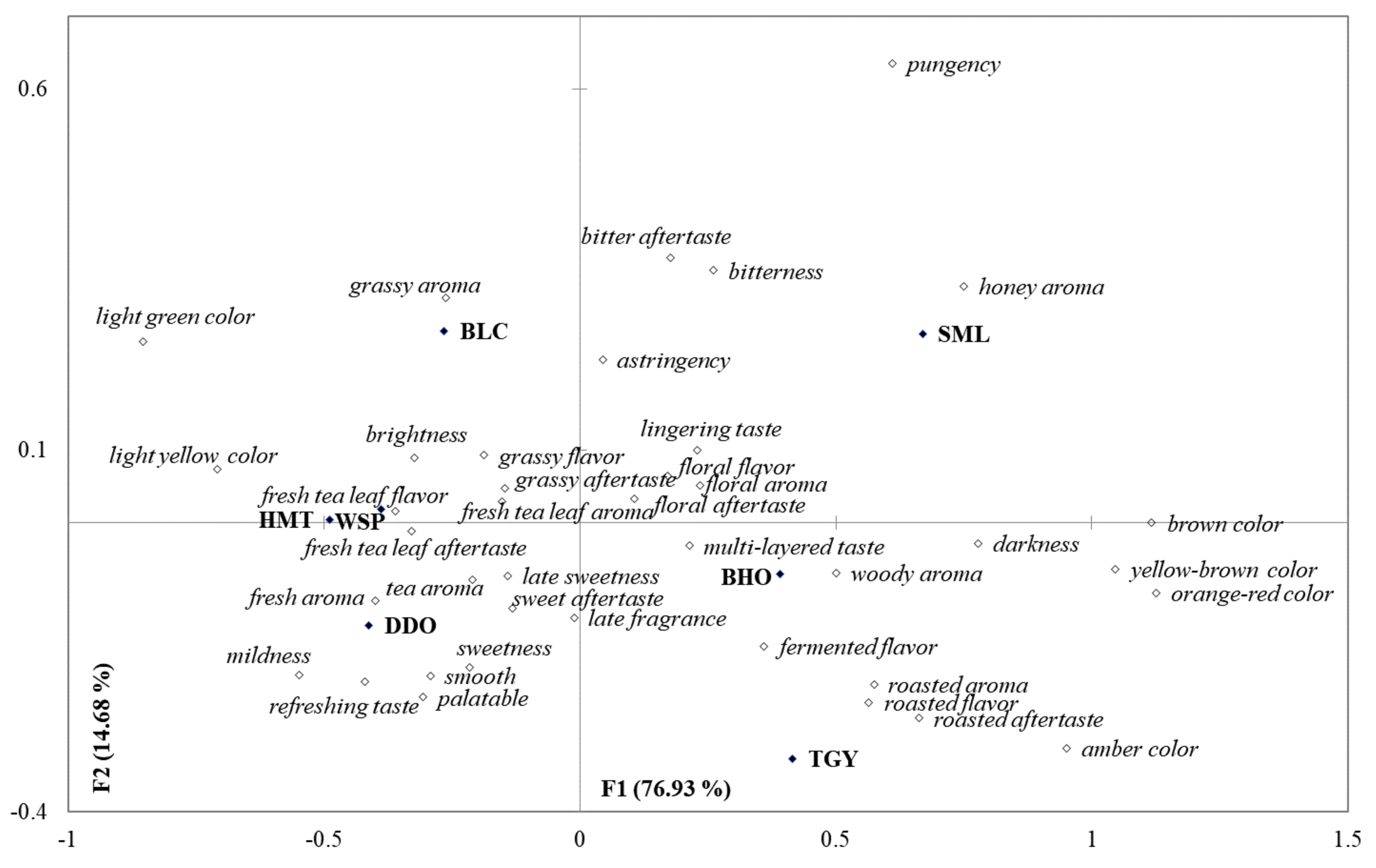
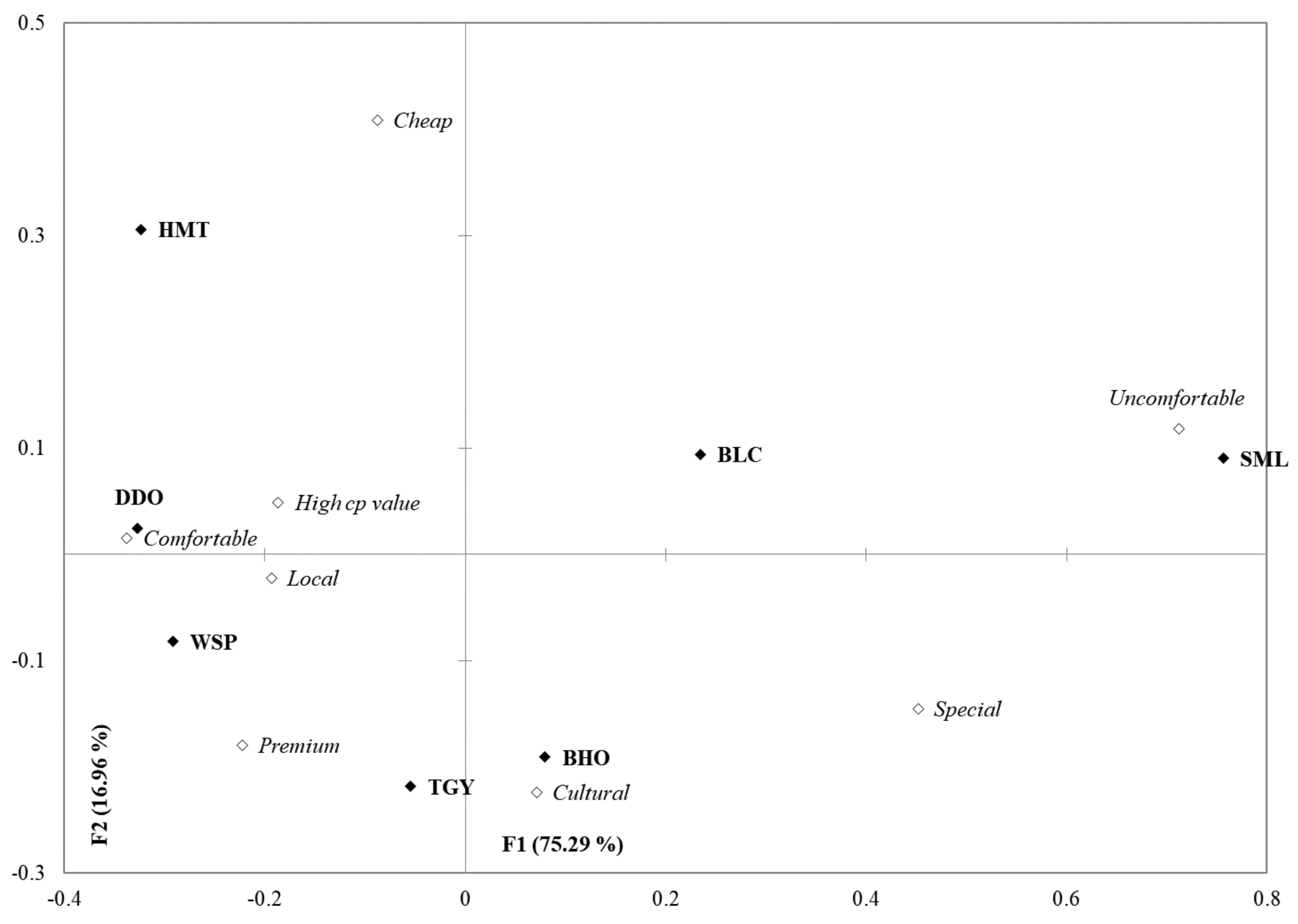
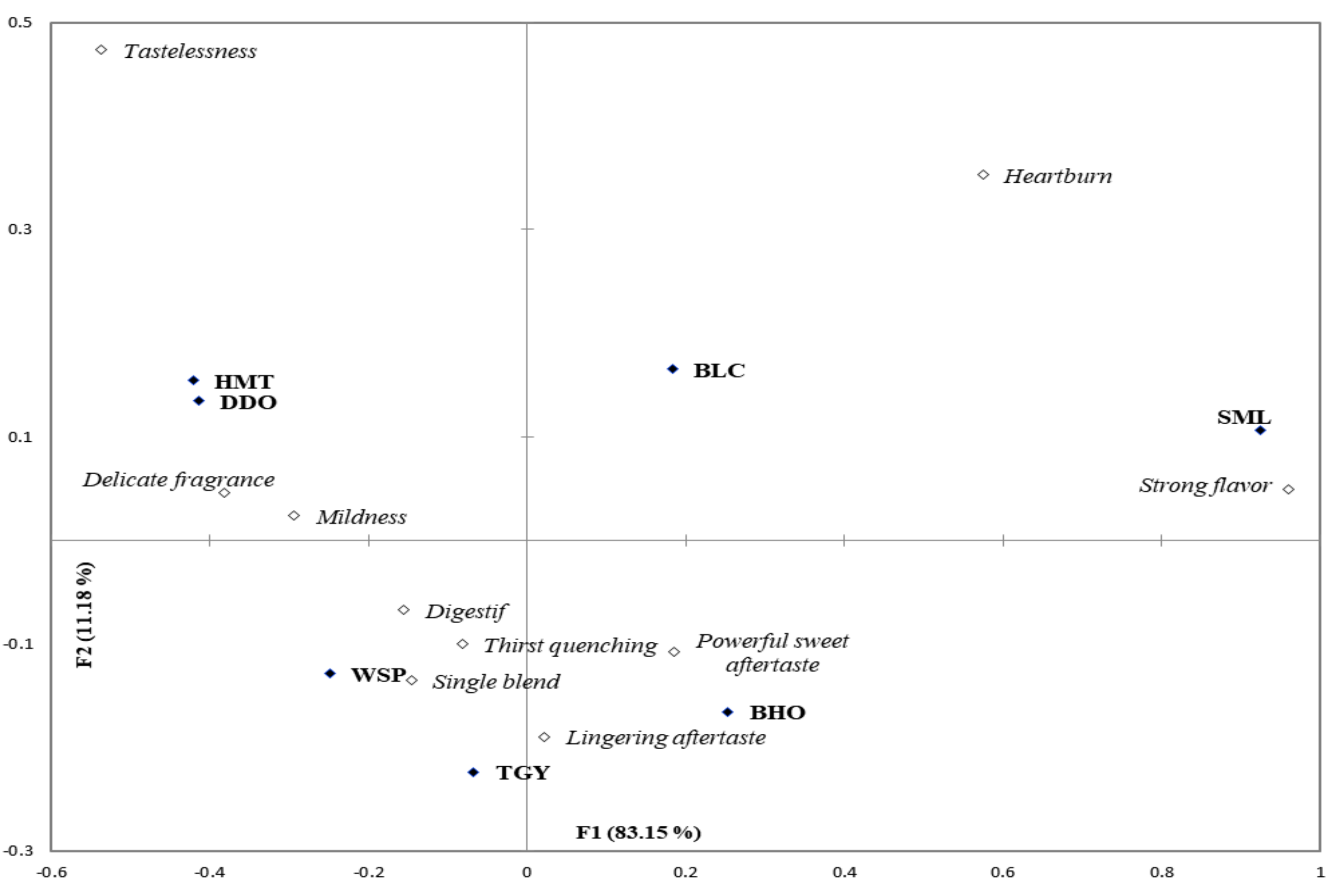
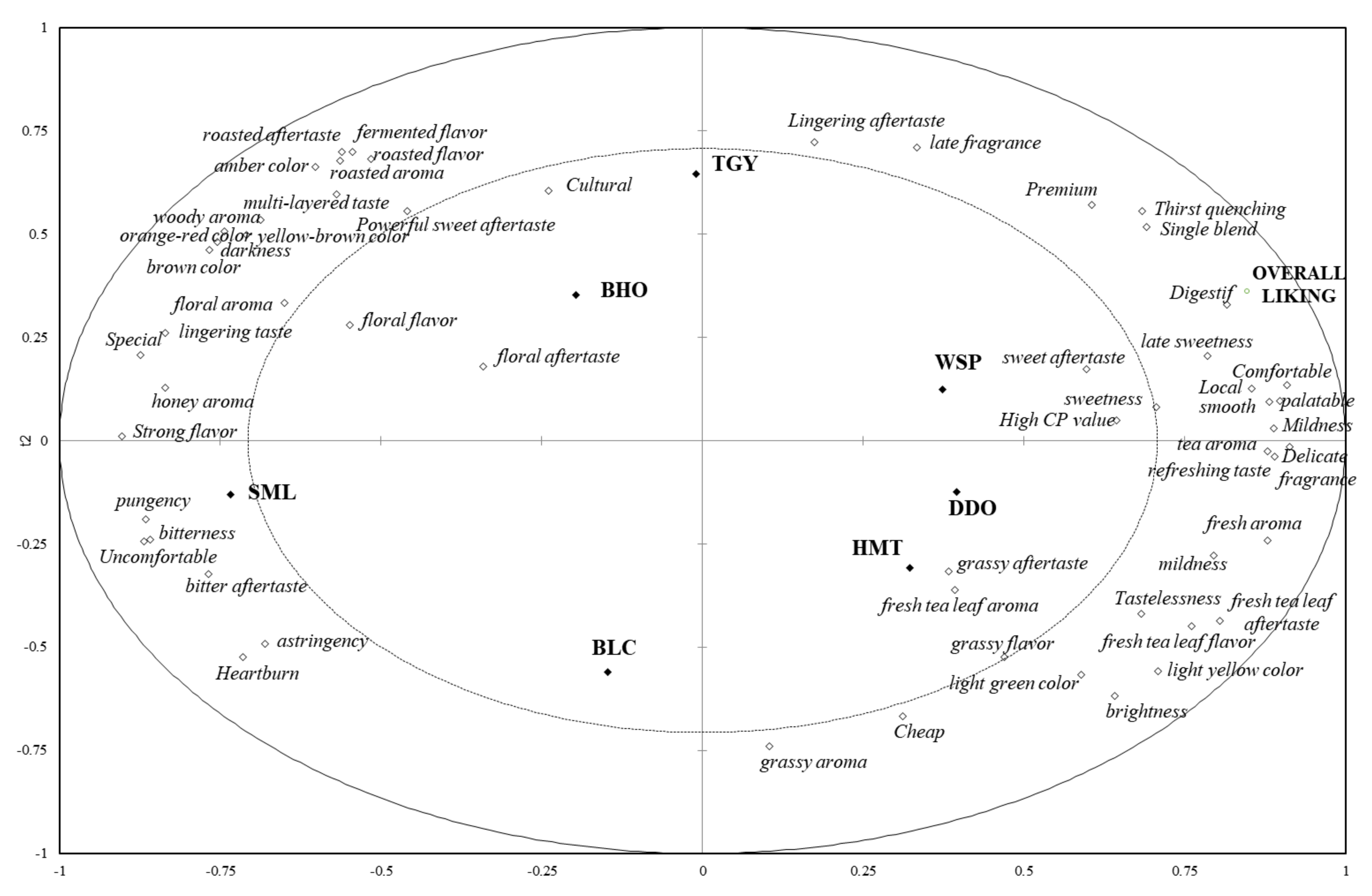
| Full Name of Tea | Abbreviation | Classification (Appearance of Dry Tea Leaves) | Fermentation Degree (%) | Origin |
|---|---|---|---|---|
| Bi-Luo-Chun tea | BLC | Green tea (bright green/curly) | 0 | New Taipei City |
| Wenshan Pouchong tea | WSP | Oolong tea (rich green/curly) | 12–15 | New Taipei City |
| High-mountain tea | HMT | Oolong tea (rich green/hemispherical) | 20–30 | Chiayi County |
| Dong Ding tea | DDO | Oolong tea (rich green/hemispherical) | 20–30 | Nantou County |
| Iron Goddess tea | TGY | Oolong tea (deep green/spherical) | 30–40 | Taipei City |
| Baihao tea | BHO | Oolong tea (multi-hued/spherical) | 60–70 | Hsinchu County |
| Yuchi Sun-Moon-Lake tea | SML | Black tea (dark brown/stretched or twisted) | >90 | Nantou County |
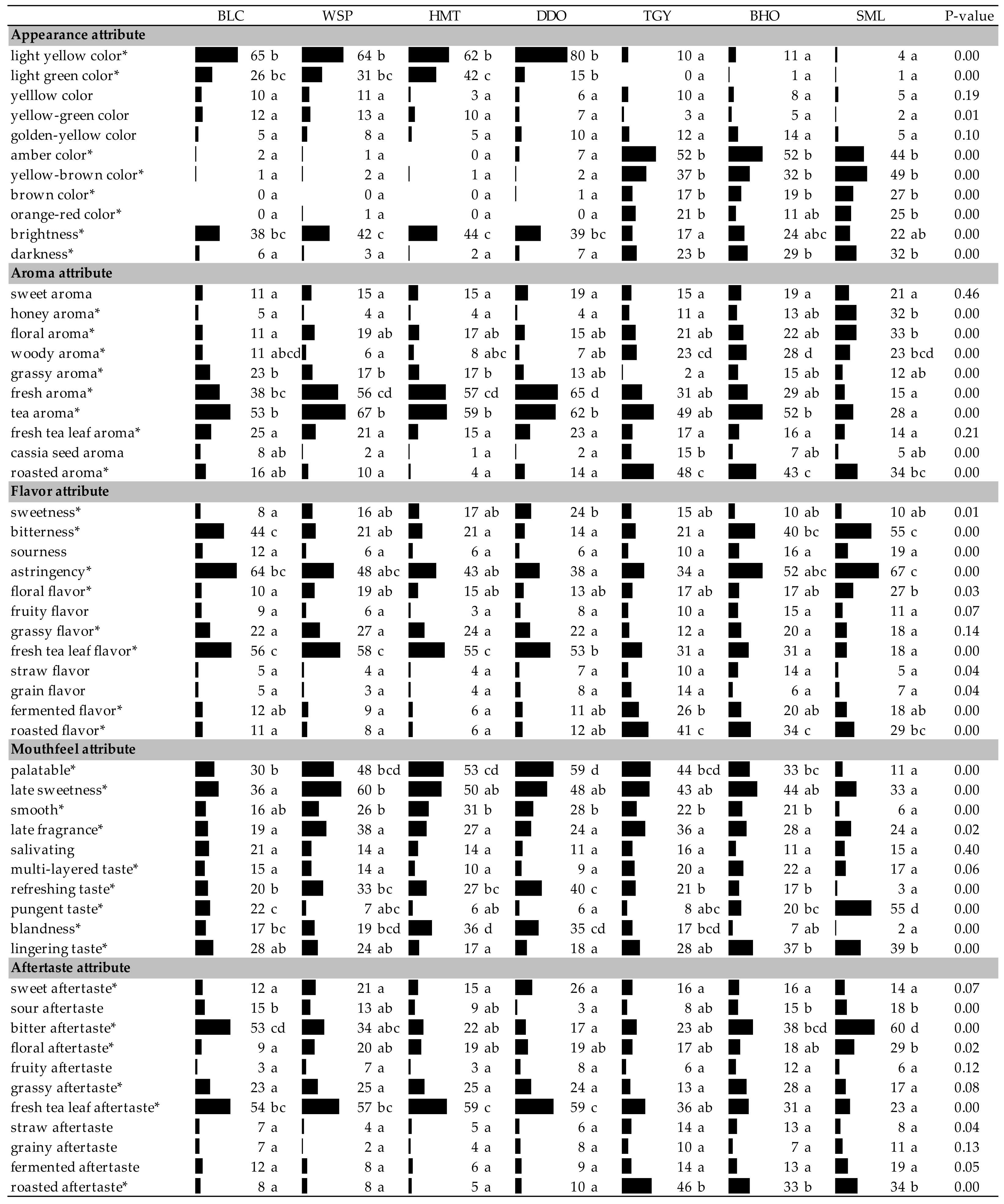
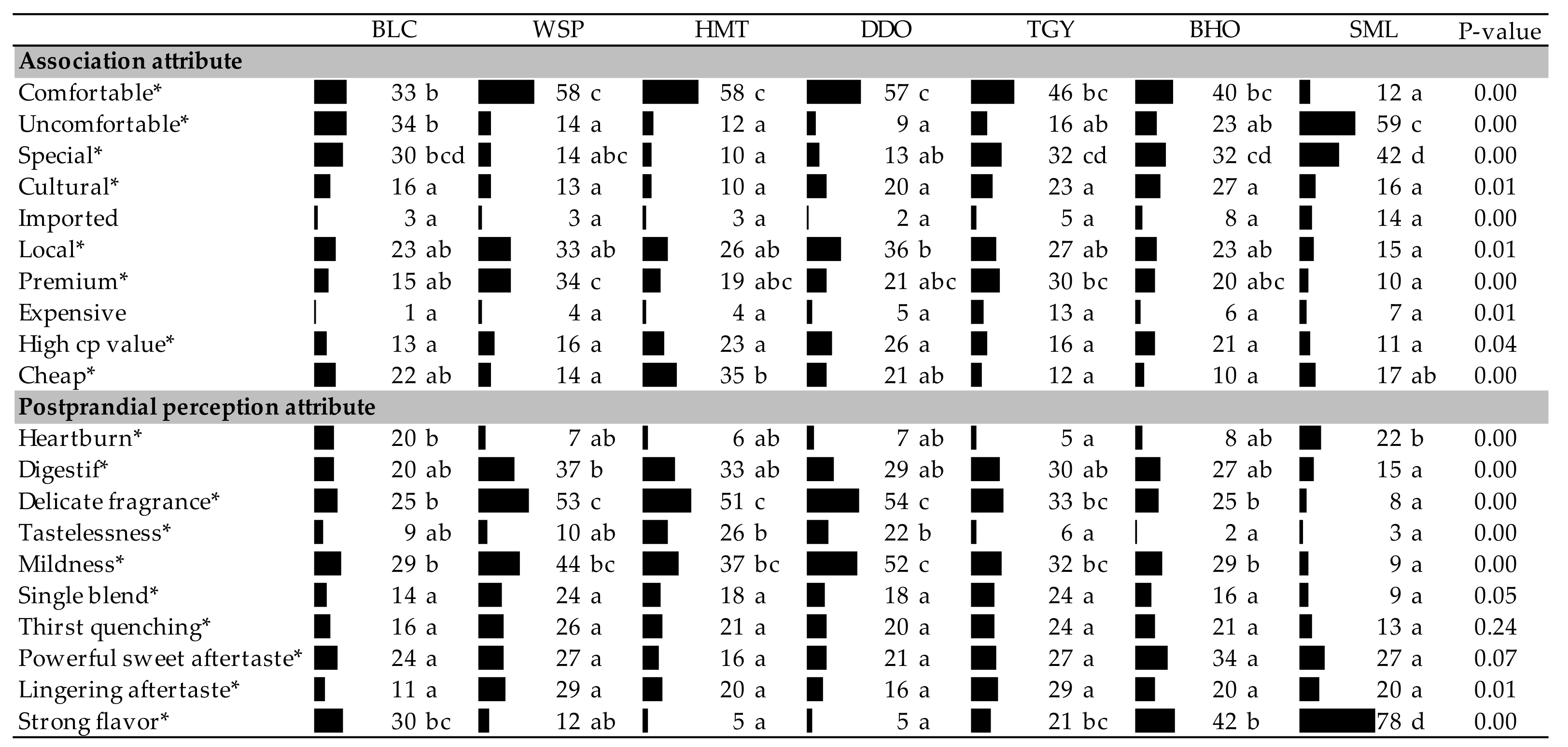
| Group | Overall Liking | Cluster 1 | Cluster 2 | Cluster 3 |
|---|---|---|---|---|
| Percentage | 109 (100%) | 37 (33.9%) | 49 (45.0%) | 23 (21.1%) |
| BLC | 4.71 ± 1.70 c | 5.59 ± 1.64 Aa | 4.82 ± 1.32 Bb | 3.04 ± 1.33 Ccd |
| WSP | 6.24 ± 1.45 a | 6.27 ± 1.35 Aa | 6.71 ± 1.12 Aa | 5.17 ± 1.72 Bab |
| HMT | 5.75 ± 1.50 ab | 5.51 ± 1.30 ABa | 6.16 ± 1.36 Aa | 5.26 ± 1.86 Bab |
| DDO | 5.91 ± 1.54 ab | 5.86 ± 1.49 Aa | 6.18 ± 1.35 Aa | 5.39 ± 1.90 Aa |
| TGY | 5.77 ± 1.85 ab | 5.81 ± 1.93 ABa | 6.20 ± 1.73 Aa | 4.78 ± 1.65 Bab |
| HBO | 5.40 ± 1.79 b | 5.41 ± 1.94 Aa | 6.12 ± 1.33 Aa | 3.87 ± 1.46 Bbc |
| SML | 4.02 ± 2.17 c | 6.32 ± 1.45 Aa | 3.16 ± 1.34 Bc | 2.13 ± 1.18 Cd |
© 2020 by the authors. Licensee MDPI, Basel, Switzerland. This article is an open access article distributed under the terms and conditions of the Creative Commons Attribution (CC BY) license (http://creativecommons.org/licenses/by/4.0/).
Share and Cite
Liou, B.-K.; Jaw, Y.-M.; Chuang, G.C.-C.; Yau, N.N.J.; Zhuang, Z.-Y.; Wang, L.-F. Important Sensory, Association, and Postprandial Perception Attributes Influencing Young Taiwanese Consumers’ Acceptance for Taiwanese Specialty Teas. Foods 2020, 9, 100. https://doi.org/10.3390/foods9010100
Liou B-K, Jaw Y-M, Chuang GC-C, Yau NNJ, Zhuang Z-Y, Wang L-F. Important Sensory, Association, and Postprandial Perception Attributes Influencing Young Taiwanese Consumers’ Acceptance for Taiwanese Specialty Teas. Foods. 2020; 9(1):100. https://doi.org/10.3390/foods9010100
Chicago/Turabian StyleLiou, Bo-Kang, Yih-Mon Jaw, George Chao-Chi Chuang, Newton N. J. Yau, Zhen-Yu Zhuang, and Li-Fei Wang. 2020. "Important Sensory, Association, and Postprandial Perception Attributes Influencing Young Taiwanese Consumers’ Acceptance for Taiwanese Specialty Teas" Foods 9, no. 1: 100. https://doi.org/10.3390/foods9010100
APA StyleLiou, B.-K., Jaw, Y.-M., Chuang, G. C.-C., Yau, N. N. J., Zhuang, Z.-Y., & Wang, L.-F. (2020). Important Sensory, Association, and Postprandial Perception Attributes Influencing Young Taiwanese Consumers’ Acceptance for Taiwanese Specialty Teas. Foods, 9(1), 100. https://doi.org/10.3390/foods9010100





